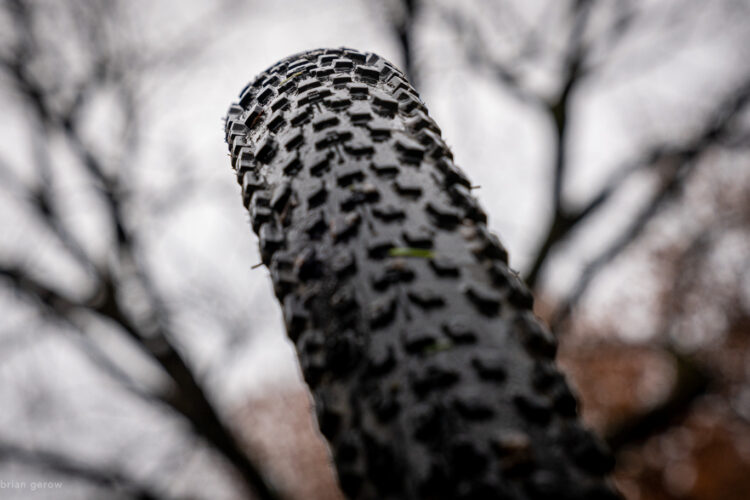
Vee Tire Co. recently added a more trail-oriented version to their gravity-focused Snap line of mountain bike tires, and judging by the tread pattern and the casing, it’s clear where its intentions lie. I’ve been testing Vee Snap Trail tires on my 29er trail bike for more than a month now, and here’s what I’ve found.
Construction, features, and setup

As Gerow mentioned back in March, the Snap Trail tire pares down the sizes of the knobs on the Snap WCE downhill tire to improve rolling resistance while also dropping the weight up to 300g per tire, depending on the configuration. The trail version of the Snap uses the same soft, 42a durometer rubber as the gravity versions, with knobs that bend and twist like a pink pencil eraser.

The Trail Snap tire is offered in either 27.5″ or 29″ diameters, at 2.35″ wide. In addition, buyers can choose either the enduro or gravity core. The former shaves a little more than 100g off the weight, while the latter makes for a burlier tire.
I was able to set up the tires tubeless front and rear on 30mm internal width rims with a simple floor pump and nary a tire lever in sight. The Trail Snap has a directional tread pattern so it’s important to note the orientation during installation. With a coating of sealant, my tires weighed 1082g and 1059g which is close to the advertised weight of 1040g for the 29×2.35″ enduro core tire.

On the trail
Riding to the trail it’s clear from the sound the Snap Trail makes on pavement that this is a knobby tire. I’m sure the rolling resistance on the Snap Trail is improved over the WCE version, but I wouldn’t say the tire is anything close to a fast roller. For a trail tire, this one sits at the aggressive end with big, heavy knobs that initially resist getting up to speed from a stop. The extra energy needed to pedal with them is noticeable.

When the trail turns up the hill, those big knobs do a great job digging in and the soft compound allows the knobs to twist and adapt to odd-shaped rocks and roots underfoot. Even in fairly wet conditions I found the tires to provide good climbing grip, though the tread pattern didn’t always shed Georgia clay as well as I would have liked. (To be fair, red Georgia clay is sticky and few tread patterns deal with it very effectively.)
Braking traction is excellent. While the knobs may be sculpted out of a softish rubber compound, they seem to be well re-enforced, allowing them to stand their ground when called upon to slow your roll. For a trail tire, the knobs are tall as well, which allows them to really dig in for emergency braking situations.

Vee specs a slightly higher TPI count on all their Snap tires than many competing tires in the same category, which promises a more supple feel while helping to reduce weight a bit. I found the sidewalls held up well through awkward rock gardens filled with jagged edges. I haven’t had a single burp or pinch flat through my tests running tire pressures in the mid to low 20s (psi).
In transitions and cornering I found the Vee Trail tire to take some getting used to, and even after a few weeks of riding the performance seems to be a little inconsistent. Sometimes I can lean the bike into a turn no problem and it hooks up great; other times I find myself slipping off line midway through. Ultimately I’m more comfortable with the Snap Trail in the rear than the front where I’d like something a little easier to handle.
At first glance the Snap tread pattern looks familiar, like a Maxxis Minion, specifically the Minion DHF. In fact, many tire brands offer tires with Minion-like tread patterns because the design tend to perform really well. Look closely, however, and there are key differences.

One of the most dramatic differences, aside from the wider, deeper cuts and siping on the Minion tread, is the fact that the corner knobs are flipped 90° counterclockwise between the two tread patterns. As a result, the Snap Trail tires provide a very different ride feel compared to the Minions.
Bottom line
Sitting toward the middle of the mountain biking spectrum, trail riders are able to pick and choose the things they like from both gravity and XC riding to suit their own style. The Vee Snap Trail tires are clearly meant for riders looking to the more aggressive end of the spectrum in terms of performance and strength. Similarly, the 2.35-inch width is geared toward hard riding at the sacrifice of the softer, more forgiving ride feel of a wider tire.
At $65, the Vee Snap Trail tire offers mountain bikers a solid level of performance.
Thank to Vee Tire Co. for providing the Snap Trail tires for testing and review.





















1 Comments
Apr 19, 2020